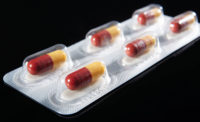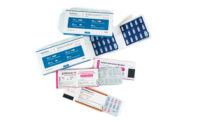A Deep Dive into Pharma Packaging Moisture Control




Moisture management in pharmaceutical packaging is a well-known necessity; tablets and capsules in bottles with commonplace solutions like sachet or canister desiccants come to mind. In addition to these oral solid dose products (OSDs), growing markets for Oral Thin Films (OTF) and Transdermal Drug Systems (patches) (TDS) can have similar protection requirements and challenges. For each of these medicine delivery formats, recent advancements in, desiccant technology offer improved protection capabilities, enabling a wide range of novel package designs for each.
But before considering package designs and desiccant options, it is helpful to look at the sources of moisture for these drug delivery products: (1) Headspace (the air within the package at the time of production), (2) moisture ingress into the package over time, and (3) the initial water content of the OSD, OTF or TDS drug product. This last factor (initial water content) is sometimes overlooked but can be crucial to proper packaging and desiccant design since, for example, packaging with unnecessarily high moisture barriers can unintentionally trap initial water content, thereby impacting stability.
It is also helpful to consider the goals and targets for moisture management within the package. These include (1) minimizing relative humidity (RH), (2) maintaining initial RH (preventing elevated RH and, on the flip side, product dry out), and (3) creating and maintaining an appropriately elevated RH environment. Along with these objectives, determining storage conditions and desired shelf life will help in selecting the ideal desiccant solution.
Adding to the challenges of moisture management is market demand to minimize package size; many solutions including flat pouches, thin thermoformed trays and blister packaging don’t have space for bulky desiccant options.
Promising Desiccant Film Technologies
Attached to existing packaging materials within existing package designs, it is now possible to extrude polymers as thin as 0.3mm, engineered and sized to absorb tailored amounts of moisture. These polymers can, achieve all of the aforementioned moisture management goals, as well as overcome all common challenges.
For example, CSP Technologies (csptechnologies.com) has developed a system for OSD blister packaging called ACTIV-BLISTER Solutions. The extruded polymer product is die-cut to fit within any blister shape and size, sitting directly beneath the capsule or tablet and completely within the sealed space of individual blisters. This product also is available in an oxygen scavenging formulation and a ‘combo’ version that provides moisture plus oxygen management benefits.
This same concept is applicable to packaging for other drug delivery formats as well. A similar solution called ACTIV-FILM Materials can be sized and applied to foil pouches and within thermoformed trays for OTF and TDS products to provide optimized desiccant capacity, using minimal space.
In all cases, the extruded polymer resides completely within the package, attached to the foil, and does not compromise the barrier properties of the packaging materials, delivering the desiccant amount needed to help achieve desired shelf life.
These engineered polymers are available in Molecular Sieve and Silica Gel desiccant formulations. Molecular Sieve is a relatively aggressive option in which moisture is absorbed and not released; it is often used when the design goal is to minimize RH within the package. In these applications, the desiccant can be sized to remove moisture not only present at the time of production and post-packaging ingress, but also to absorb water content from the OSD, OTF or TDS itself. In other words, it’s removing moisture not just from the packaging headspace, but also from the actual product.
This capability could even be used to help eliminate a drying process in the manufacturing of the drug product. In contrast, for applications where over-drying of the product is a concern, Silica Gel can be used to provide an RH buffer, preventing spikes in RH without over-drying the head space. By pairing barrier protection with Silica Gel capacity, fluctuations in RH can be minimized.
For each of these solutions, desiccant capacity is set by varying the thickness, footprint, and formulation to provide the desired performance and meet the application objectives. The rate of moisture absorption and release also can be tailored.
Advanced Considerations and Benefits
An important feature of these desiccants is that they are applied to the inside of the package with heat and pressure, a process often referred to as ‘heat-staking’ that utilizes the sealing layer of the foil lidding. This not only eliminates the cost of adhesives and necessary backing films, but also eliminates residual solvents found in adhesives. These solvents have the potential to migrate into the package headspace as well as into the product, and show up in analytic tests as impurities. The off-gassing of solvents also can create odors in the package.
Fortunately, these solutions are far more complex than their implementation, as in the vast majority of production lines they are fairly easy to implement. Incorporating the solutions can be done on existing packaging equipment by adding a module to feed, cut and heat-stake the engineered film to the foil material during production. Taking a platform approach, these modules can allow for a range of desiccant sizes and formulations to support multiple products, and can be idled when a desiccant is not needed. The desiccants are provided in roll format that can be sized to support various lot sizes and machine run-times.
Holistic Approach
The development process begins with the desired package design and RH objectives, from which a theoretical analysis can be conducted to propose an optimized design — in doing so pairing desiccant with packaging to create an optimized moisture protection system. Desiccant samples can then be produced for small scale testing to enable design decisions and further optimization before any machine modifications occur. This lab testing can include measuring the internal RH over time and how quickly the desiccant capacity is used — this data helps characterize the performance of the total package.
It is important and interesting to note that, when working with desiccants, the total package design must not only provide sufficient capacity in order to deliver protection over time, but also consider the speed at which the target RH is obtained – that is, how quickly moisture is reduced or elevated can be important to shelf life. Designing for — and characterizing both — capacity and speed can ultimately provide a best package design and shelf life for each of these drug product formats.
Looking for a reprint of this article?
From high-res PDFs to custom plaques, order your copy today!









